
Salvia guaranitica, the anise-scented sage or hummingbird sage, is a species of flowering plant in the sage family, Lamiaceae, native to a wide area of South America, including Brazil, Paraguay, Uruguay, and Argentina. It is cultivated all over the world, and is naturalized in New Zealand and Chile.

Salvia pratensis, the meadow clary or meadow sage, is a species of flowering plant in the family Lamiaceae, native to Europe, western Asia and northern Africa. The Latin specific epithet pratensis means "of meadows", referring to its preferred habitat. It also grows in scrub edges and woodland borders.
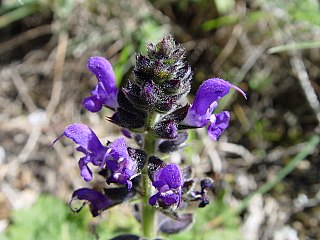
Salvia verbenaca, also known as wild clary or wild sage, is native to the British Isles, the Mediterranean region in Southern Europe, North Africa, and Near East, and in the Caucasus. It can be found as an introduced species that has naturalized in many parts of the world, including the Eastern United States, California, Mexico, Argentina, Uruguay, Southern Africa, Tasmania, New Zealand and China.

Salvia is the largest genus of plants in the sage family Lamiaceae, with nearly 1000 species of shrubs, herbaceous perennials, and annuals. Within the Lamiaceae, Salvia is part of the tribe Mentheae within the subfamily Nepetoideae. One of several genera commonly referred to as sage, it includes two widely used herbs, Salvia officinalis and Salvia rosmarinus.

Salvia patens, the gentian sage or spreading sage, is a species of flowering plant in the sage family Lamiaceae that is native to a wide area of central Mexico. This herbaceous perennial was introduced into horticulture in 1838 and popularized a hundred years later by the Irish gardener and botanist William Robinson (1838-1935).
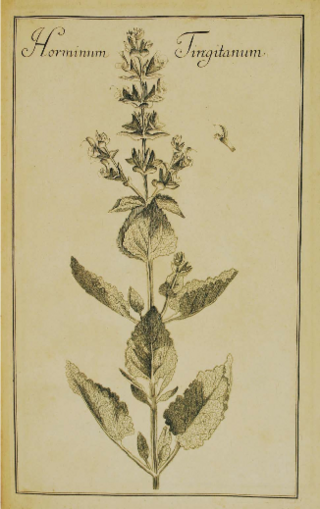
Salvia tingitana is an herbaceous perennial in the family Lamiaceae. It has a long and enigmatic history—it has been grown and described since the 17th century without any certainty about its origin. Botanists' speculation that it was native to northern Africa is reflected in the specific epithet tingitana, which refers to the town of "Tingi", even though no native plants have ever been found there. It was not until 1989 that a wild population of the plant was discovered, in western Saudi Arabia. The plant is regarded as a rather strong mosquito repellent commonly used in traditional medicine of Behbahan where it blooms around March.

Salvia taraxacifolia is a species of flowering plant in the Lamiaceae family. It is referred to by the common name Dandelion leaved sage and is a herbaceous perennial shrub that is endemic to southwest Morocco, growing in the Atlas Mountains at elevations ranging from 2,000 feet (610 m) to 8,000 feet (2,400 m). Very adaptable, it grows on limestone slopes, forest clearings, and rocky riversides. It has no close allies in the genus Salvia. The specific epithet, taraxacifolia, is likely Persian in origin and means 'leaves shaped like a dandelion'.

Salvia tiliifolia is a vigorous, herbaceous annual in the family Lamiaceae that is native to Central America. As a pioneer of abused areas, the plant has spread in modern times into: South America, as far south as Peru and Bolivia; the southwestern regions of the United States, including the states Texas and Arizona; Africa, including South Africa and Ethiopia; China, including the provinces of Yunnan and Sichuan.
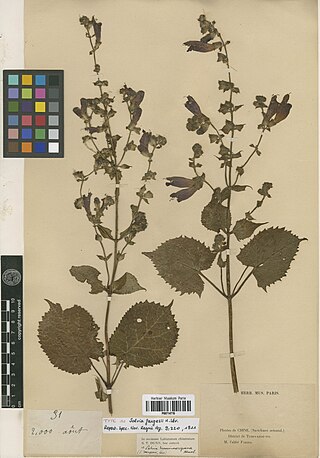
Salvia maximowicziana is a perennial plant that is found growing on grasslands, forests, and forest edges in China, at 1,800 to 3,300 m elevation. It grows 10 to 90 cm tall, with circular-cordate to ovate-cordate leaves that are typically 3 to 8 cm long and 6 to 8 cm wide. The upper leaf surface is nearly smooth, or lightly covered with hairs, while the underside has glandular hairs on the veins.
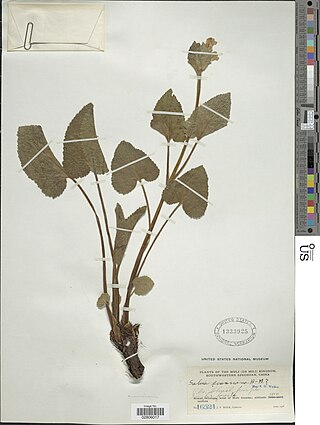
Salvia evansiana is a perennial plant that is native to Sichuan and Yunnan provinces in China, found growing on alpine meadows, hillsides, and forests at elevations from 3,400 to 4,300 m. It has erect stems growing 13 to 45 cm tall, with ovate to triangular-ovate leaves that are 2 to 11 cm long and 1 to 11 cm wide.
Salvia stibalii, synonym Salvia paucifloraE.Peter, is a perennial plant that is native to Yunnan province in China, growing in and around forests at 2,800 to 3,400 m elevation.

Salvia campanulata is a perennial plant that is native to Xizang and Yunnan provinces in China, along with locations in Bhutan, India (Sikkim), Myanmar, and Nepal. It is typically found growing at 800 to 3,800 m elevation in and around forests, on hillsides, and in valleys. There are four named varieties.
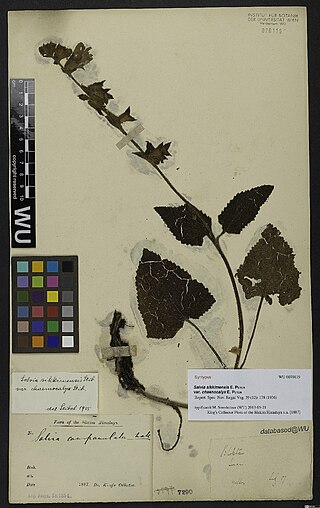
Salvia sikkimensis is a perennial plant that is native to Xizang province in China, along with locations in Bhutan and India (Sikkim). It is typically found growing in and around forests, on hillsides, and streamsides at 3,300 m (10,800 ft) elevation.
Salvia ekimiana is a perennial plant that is endemic to Central Anatolia in Turkey, growing in open pine forest and alpine steppe at 1,700 to 2,000 m elevation.
Salvia breviconnectivata is an annual or biennial herb that is native to Yunnan province in China, found growing along roadsides at 1,800 m (5,900 ft) elevation. S. breviconnectivata grows on erect stems to 35 cm (14 in) tall. Inflorescences are 2–6 flowered widely spaced verticillasters in terminal racemes that are 8 to 15 cm, with a reddish corolla that is 1.1 cm (0.43 in).

Salvia deserta is a perennial plant that is native to Xinjiang province in China, and the countries of Kazakhstan and Kyrgyzstan. It grows in wastelands, sandy grasslands, and along streams in forests at elevations from 300 to 1,800 m.
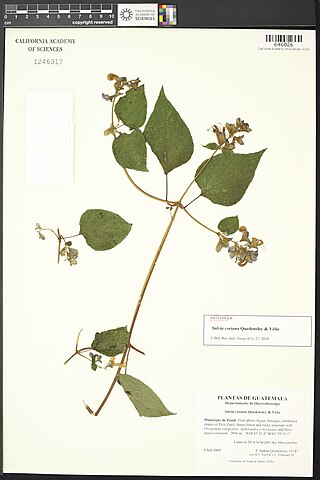
Salvia coriana is a perennial plant that is endemic to tropical cloud forest in Guatemala, growing at approximately 2,000 m (6,600 ft) elevation on the northwestern slopes of Pico Zunil in the Sierra Chuatroj range.

Salvia personata is an annual herb that is native to valleys and foothills in the Andes of Bolivia and northern Argentina. It grows in disturbed bushy habitat at 600 to 2,600 m elevation.
Salvia anatolica is a rare perennial herb that is endemic to a small area between Divriği and Kemaliye in Turkey, growing on stony slopes and oak scrub forest at 1,500 to 1,650 m elevation. It is similar to another Salvia that is endemic to Turkey, S. bracteata.
Salvia hasankeyfensis is a recently identified species of wild sage native to the town of Hasankeyf in southeast Turkey and surrounding areas. The species was discovered during fieldwork in Hasankeyf in 2014 by Tuncay Dirmenci and Özal Güner, and described by them in a 2015 paper written with Ferhat Celep. It appears to be related to Salvia verbenaca, but the authors identify many distinguishing characteristics including S. hasankeyfensis's white petals, and the shapes of the plants' leaves at the base and along the stem. They say it "clearly differs in having denser, narrower, subsessile leaves [that are] always pinnatisect, oblong in outline, a completely different indumentum and white flowers."














